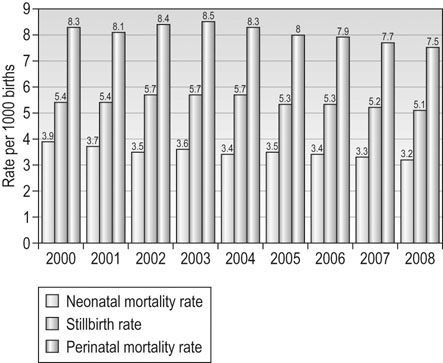Perinatal and maternal mortality
Perinatal mortality
Introduction
Definitions
• Live birth: complete expulsion or extraction from its mother of a product of conception, irrespective of the duration of the pregnancy, which, after such separation, breathes or shows any other evidence of life, such as beating of the heart, pulsation of the umbilical cord, or definite movement of voluntary muscles, whether or not the umbilical cord has been cut or the placenta is attached; each product of such a birth is considered live born.
• Stillbirth or fetal death: death prior to the complete expulsion or extraction from its mother of a product of conception, irrespective of the duration of pregnancy; the death is indicated by the fact that after such separation the fetus does not breathe or show any other evidence of life, such as beating of the heart, pulsation of the umbilical cord or definite movement of voluntary muscles.
• Perinatal period: commences at 22 completed weeks (154 days) of gestation and ends seven completed days after birth.
• Neonatal period: begins with birth and ends 28 complete days after birth. Neonatal deaths may be subdivided into early neonatal deaths, occurring during the first seven days of life (0–6 days), and late neonatal deaths, occurring after the seventh day but before the 28th day of life (7–27days).
In the UK the definitions are different, reflecting the survival rates and concept of viability. The present legal definitions that apply to England and Wales are as follows:
• Stillbirth: A baby delivered without signs of life after 23+6 weeks of pregnancy.
• Neonatal death: death of a liveborn infant occurring within 28 days of birth; an early neonatal death is defined as death during the first week of life (0–6 completed days inclusive).
• Perinatal death: death of a fetus or a newborn in the perinatal period that commences at 24 completed weeks gestation and ends before 7 completed days after birth.
In Australia and New Zealand, stillbirth is defined as ‘Death prior to the complete expulsion or extraction from its mother of a product of conception of 20 or more completed weeks of gestation or of 400 g or more birth weight where gestation is not known. The death is indicated by the fact that after such separation the fetus does not breathe or show any other evidence of life, such as beating of the heart, pulsation of the umbilical cord, or definite movement of voluntary muscles’.
Mortality rates
The current definitions are as follows:
• Perinatal mortality rate (PNMR): the number of stillbirths and early neonatal deaths (those occurring in the first week of life) per 1000 total births (live births and stillbirths)
• Stillbirth rate (SBR): the number of stillbirths per 1000 total births
• Neonatal mortality rate (NMR): the number of neonatal deaths occurring within the first 28 days of life per 1000 live births.
Incidence
WHO publishes global estimates on perinatal mortality rates by level of development and geographical regions. For comparison, the regions are divided into the ‘More developed, Less developed and Least developed’ with figures demonstrating a stark contrast between the regions (Table 5.1). In countries where no data collection takes place, models are produced to estimate mortality based on demographic and health surveys conducted by several agencies. Worldwide, there are over 6.3 million perinatal deaths annually, almost all of which occur in developing countries, and 27% occurring in the least developed countries alone, i.e. the sub-Saharan regions of central Africa. In developing countries, the PNMR is five times greater than in developed countries; in the least developed countries it is six time higher. It is highest in Africa, with 62 deaths per 1000 births, especially in middle and western Africa, with rates as high as 76 per 1000 births. The perinatal mortality rate in Asia is 50 per 1000 total births, with a peak of 65 per 1000 in South-central Asia.
Table 5.1
Global comparison of perinatal and neonatal mortality rates by WHO regions in 2000
| Region | Perinatal mortality rate (per 1000 births) | Stillbirth rate (per 1000 births) | Early neonatal rate (per 1000 live births) | Neonatal mortality rate (per 1000 live births) |
| More developed | 10 | 6 | 4 | 5 |
| Less Developed | 50 | 26 | 25 | 33 |
| Least Developed | 61 | 31 | 31 | 42 |
| World | 47 | 24 | 23 | 41 |

(Source: World Health Organization (2006) Neonatal and Perinatal Mortality: Country, Regional and Global Estimates. WHO Press, Geneva.)
Developed countries (Western Europe, North America, Japan, Australia and New Zealand) have seen a steady fall in the PNMR over the last 30 years. In the UK, the Centre for Maternal and Child Enquiries (CMACE) publishes annual perinatal reports and showed a statistically significant downward trend in the perinatal mortality rate, from 8.3 in 2000 to 7.5 per 1000 total births in 2008. This is due to both a statistically significant decrease in the early neonatal mortality rate (from 2.9 in 2000 to 2.5 in 2008 per 1000 live births) and a statistically significant decrease in the stillbirth rate ( from 5.4 to 5.1 per 1000 live births, respectively) (Fig. 5.1).
Sociodemographic factors and perinatal mortality
Factors that are known to affect perinatal mortality in the UK and Australia include the sociodemographic characteristics of the mother such as maternal age, deprivation, ethnicity (Table 5.2). Smoking also has a significant adverse effect on birth weight and perinatal mortality.
Table 5.2
Sociodemographic characteristics of mothers: England, Wales, Northern Ireland and the Crown Dependencies, 2008
| Stillbirth rate (per 1000 births) | Neonatal death rate (per 1000 live births) |


